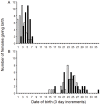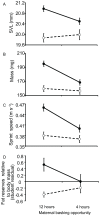Effects of maternal basking and food quantity during gestation provide evidence for the selective advantage of matrotrophy in a viviparous lizard
- PMID: 22848629
- PMCID: PMC3406071
- DOI: 10.1371/journal.pone.0041835
Effects of maternal basking and food quantity during gestation provide evidence for the selective advantage of matrotrophy in a viviparous lizard
Abstract
The evolution of matrotrophy (i.e., direct supply of nutrients by the mother during gestation) may be associated with high maternal energy availability during gestation. However, we lack knowledge about the selective advantages of matrotrophic viviparity (live-bearing) in reptiles. In reptiles, the interaction between body temperature and food intake affect maternal net energy gain. In the present study, we examined the effects of basking and food availability (2 by 2 factorial design) during gestation on offspring phenotype in a matrotrophic viviparous lizard (Pseudemoia entrecasteauxii). Subsequently, we investigated if the maternal effects were context-dependent using offspring growth rate as an indicator of the adaptive significance of matrotrophy. Offspring were exposed either to the same thermal conditions as their mothers experienced or to thermal conditions different from those experienced by their mothers. We provide the first evidence that an interaction between maternal thermal and maternal food conditions during gestation strongly affects offspring phenotype, including date of birth, body size and performance ability, which affect offspring fitness. Offspring growth rate was dependent on offspring thermal conditions, but was not influenced by maternal effects or offspring sex. Matrotrophic viviparity provided gravid females with the means to enhance offspring fitness through greater energetic input to offspring when conditions allowed it (i.e., extended basking opportunity with high food availability). Therefore, we suggest that selective advantages of matrotrophic viviparity in P. entrecasteauxii may be associated with high maternal energy availability during gestation.
Conflict of interest statement
Figures



Similar articles
-
Geographical differences in maternal basking behaviour and offspring growth rate in a climatically widespread viviparous reptile.J Exp Biol. 2014 Apr 1;217(Pt 7):1175-9. doi: 10.1242/jeb.089953. Epub 2013 Dec 5. J Exp Biol. 2014. PMID: 24311810
-
Do gravid females become selfish? Female allocation of energy during gestation.Physiol Biochem Zool. 2012 May-Jun;85(3):231-42. doi: 10.1086/665567. Epub 2012 Apr 3. Physiol Biochem Zool. 2012. PMID: 22494979
-
Potentially adaptive effects of maternal nutrition during gestation on offspring phenotype of a viviparous reptile.J Exp Biol. 2011 Dec 15;214(Pt 24):4234-9. doi: 10.1242/jeb.057349. J Exp Biol. 2011. PMID: 22116767
-
Mechanisms of reproductive allocation as drivers of developmental plasticity in reptiles.J Exp Zool A Ecol Integr Physiol. 2018 Jul;329(6-7):275-286. doi: 10.1002/jez.2165. Epub 2018 May 7. J Exp Zool A Ecol Integr Physiol. 2018. PMID: 29733527 Review.
-
Matrotrophy and placentation in invertebrates: a new paradigm.Biol Rev Camb Philos Soc. 2016 Aug;91(3):673-711. doi: 10.1111/brv.12189. Epub 2015 Apr 29. Biol Rev Camb Philos Soc. 2016. PMID: 25925633 Free PMC article. Review.
Cited by
-
Food restriction affects maternal investment but not neonate phenotypes in a viviparous lizard.Zool Res. 2017 Mar 18;38(2):81-87. doi: 10.24272/j.issn.2095-8137.2017.011. Zool Res. 2017. PMID: 28409503 Free PMC article.
-
Prenatal stress from trawl capture affects mothers and neonates: a case study using the southern fiddler ray (Trygonorrhina dumerilii).Sci Rep. 2017 Apr 12;7:46300. doi: 10.1038/srep46300. Sci Rep. 2017. PMID: 28401959 Free PMC article.
-
The Influence of Environmental Variables on Home Range Size and Use in the Golden Snub-Nosed Monkey (Rhinopithecus roxellana) in Tangjiahe National Nature Reserve, China.Animals (Basel). 2022 Sep 8;12(18):2338. doi: 10.3390/ani12182338. Animals (Basel). 2022. PMID: 36139197 Free PMC article.
-
Low food availability during gestation enhances offspring post-natal growth, but reduces survival, in a viviparous lizard.Oecologia. 2019 Mar;189(3):611-620. doi: 10.1007/s00442-019-04349-5. Epub 2019 Feb 5. Oecologia. 2019. PMID: 30725369
-
Live bearing promotes the evolution of sociality in reptiles.Nat Commun. 2017 Dec 11;8(1):2030. doi: 10.1038/s41467-017-02220-w. Nat Commun. 2017. PMID: 29229907 Free PMC article.
References
-
- Mousseau TA, Fox CW (1998) Maternal Effects as Adaptations. New York: Oxford University Press.
-
- Galloway LF (2005) Maternal effects provide phenotypic adaptation to local environmental conditions. New Phytol 166: 93–99 doi: 10.1111/j.1469-8137.2004.01314.x. - DOI - PubMed
-
- Lindholm AK, Hunt J, Brooks R (2006) Where do all the maternal effects go? Variation in offspring body size through ontogeny in the live-bearing fish Poecilia parae . Biol Letters 2: 586–589 doi: 10.1098/rsbl.2006.0546. - DOI - PMC - PubMed
-
- Wapstra E, Uller T, While GM, Olsson M, Shine R (2010) Giving offspring a head start in life: field and experimental evidence for selection on maternal basking behaviour in lizards. J Evol Biol 23: 651–657 doi: 10.1111/j.1420-9101.2009.01924.x. - DOI - PubMed
Publication types
MeSH terms
LinkOut - more resources
Full Text Sources

